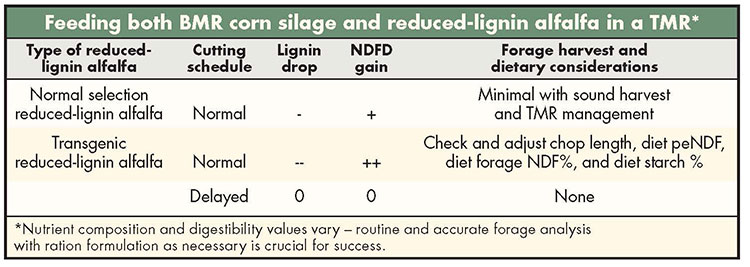Doubling down on reduced lignin |
| By Randy Shaver |
|
|
The author is a professor and extension dairy nutritionist in the department of dairy science at the University of Wisconsin-Madison. With the introduction of reduced-lignin alfalfa, some users are asking if pairing the product with brown midrib corn will result in too much digestible fiber. Brown midrib (BMR) hybrid corn silages are known for their significant reductions in lignin content and coinciding higher in vitro NDF digestibility (ivNDFD) compared to conventional hybrid corn silages. In numerous controlled dairy feeding trials from multiple locations and years, these corn silage nutrient composition improvements have translated into greater dry matter intake and milk yield. Concerns remain about agronomic and yield drag challenges; even so, BMR corn silages have become the preferred hybrid choice for many high-producing dairy herds. More recently, reduced-lignin alfalfa varieties have become commercially available. Thus, questions are being raised as to whether or not total ration forage ivNDFD can become too high for dairy cows if both forage types comprise a major component of the dairy ration. Some lignin is needed Lignin is an important polymer in the plant cell wall for strength and rigidity to prevent lodging. It also is necessary for water transport within the plant. Thus, there is a built-in safety factor against forage lignin becoming too low, and hence NDF digestibility being too high, from an agronomic standpoint. Reduced-lignin alfalfa varieties developed from either conventional plant breeding or transgenic approaches are being marketed by separate companies. Relative to normal-lignin varieties, 5 to 15 percent reductions in lignin content and up to a 15 percent improvement in ivNDFD and relative forage quality (RFQ) have been reported for the reduced-lignin alfalfas in research trials. The greatest differences have been found with the transgenic varieties. By contrast, ivNDFD is typically about 20 percent greater for BMR corn hybrids relative to nonBMR hybrids. The ivNDFD for by-product fiber sources, such as soyhulls or beet pulp, can be as much as 60 percent greater than the ivNDFD for normal-lignin forages. So, reduced-lignin forages possess ivNDFD values that are workable within dairy cattle feeding programs. Harvesting alfalfa at the mid- to late-bud stage of maturity, compared to more mature stages, lowers NDF and lignin contents and boosts the percentage of crude protein (CP) and ivNDFD. This is mainly a function of harvesting plants with a greater leaf-to-stem ratio. Even prior to the release of reduced-lignin alfalfa, dairy farmers have had the experience of feeding early-cut, high-quality alfalfa haylage along with BMR corn silage. More harvest options The downside to cutting at earlier plant maturities and imposing shorter intervals between cuttings has been reduced alfalfa dry matter yield per acre, more cuttings (and harvest costs) per year, and compromised stand longevity. Reduced-lignin alfalfa offers growers enhanced harvest flexibility. One option with reduced-lignin alfalfa is to simply capture higher quality forage through greater ivNDFD at your current harvest maturity and cutting frequency. Another option might be to widen the cutting interval to capture more yield per acre of similar quality alfalfa to that which is currently being obtained from normal-lignin varieties. Marketers of the transgenic varieties promote the latter approach as a means to eliminate a cutting and save the associated harvest costs. Expect lignin content and ivNDFD to vary for reduced-lignin alfalfa due to differences in the variety, harvest strategy, and the typical harvest time weather-induced variation in quality. Note that the latter of these also influences the variation in CP and NDF contents. Keep in mind, too, that it will take about three years for all acreage on a farm to be converted over to reduced-lignin alfalfa; this results in a mixture of both reduced- and normal-lignin alfalfas being harvested and fed during that time period. As with normal-lignin alfalfa, frequent sampling and accurate nutrient analysis of reduced-lignin alfalfa and also BMR corn silage are crucial to developing successful rations.  Ration adjustments Usage considerations for the reduced-lignin forages are listed in the chart. Only in situations with major lignin reductions and ivNDFD increases from the reduced-lignin alfalfa might significant extra attention to detail be necessary. Changes may include: 1) boosting TMR (total mixed ration) physically-effective NDF through greater dietary forage and forage-NDF content, 2) reducing dietary starch content, and/or 3) lengthening silage chop settings. Reduced milkfat content and/or feed efficiency, measured as dry matter intake relative to level of milk production, can be good group or herd diagnostic indicators that these types of interventions are necessary. To date, I am unaware of controlled feeding trials in dairy cattle where both reduced-lignin alfalfa haylage and BMR corn silage have been fed together in the same TMR for evaluation. This makes the practice at this point still a learn-as-you-go experience on the farm. So, work closely with your nutritionist to set the forage sampling and analysis protocols, interpret test reports, and take extra care to formulate feed rations when using both reduced-lignin alfalfa and BMR corn silage together in the TMR. This article appeared in the March 2018 issue of Hay & Forage Grower on pages 18 and 19. Not a subscriber? Click to get the print magazine |
